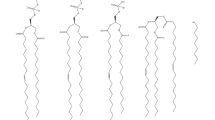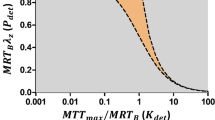Abstract
We have studied by digital computer simulation the effect of concentration-dependent plasma protein and tissue binding on the time course of drug concentrations (both unbound and total) in plasma following rapid injection of a drug whose elimination rate is proportional to either free or total drug concentration in plasma, assuming instantaneous equilibration of the drug between vascular and nonvascular spaces. The following observations were made when elimination rate was assumed to be a function of free drug concentration: (a) when plasma protein binding is nonlinear and there is either no tissue binding or linear tissue binding, log concentration-time plots of free drug are always concave whereas such plots for total (sum of free and bound) drug can be convex, almost linear, or concave (apparently biexponential) depending on the plasma protein binding parameters relative to the initial concentration; (b) linear tissue binding in association with nonlinear plasma protein binding can reduce the concavity or enhance the convexity of log total concentration-time plots. When drug elimination rate was assumed to be a function of total concentration in plasma, nonlinear plasma protein binding in association with linear or no tissue binding yielded convex log total concentration-time plots which could sometimes be described by Michaelis-Menten kinetics. In general, drug concentration-dependent changes in the apparent volume of distribution resulting from nonlinear plasma protein and (where applicable) tissue binding have a pronounced effect on the slope of log total plasma concentration- time plots. It appears that under clinically realistic conditions an otherwise marked curvature of such plots, due to nonlinear plasma protein binding, may in fact be dampened or overcome by linear tissue binding.
Similar content being viewed by others
References
G. Levy and A. Yacobi. Effect of plasma protein binding on elimination of warfarin.J. Pharm. Sci. 63:805–806 (1974).
G. R. Wilkinson and D. G. Shand. A physiologic approach to hepatic drug clearance.Clin. Pharmacol. Ther. 18:377–390 (1975).
M. Gibaldi and P. J. McNamara. Apparent volumes of distribution and drug binding to plasma proteins and tissues.Eur. J. Clin. Pharmacol. 13:373–378 (1978).
M. Gibaldi, G. Levy, and P. J. McNamara. Effect of plasma protein and tissue binding on the biologic half-life of drugs.Clin. Pharmacol. Ther. 24:1–4 (1978).
E. Krüger-Thiemer, W. Diller, and P. Bünger. Pharmacokinetic models regarding protein binding of drugs.Antimicrob. Agents Chemother. 5:183–191 (1965).
J. J. Coffey, F. J. Bullock, and P. T. Schoenemann. Numerical solution of nonlinear pharmacokinetic equations: Effects of plasma protein binding on drug distribution and elimination.J. Pharm. Sci. 60:1623–1628 (1971).
B. K. Martin. Kinetics of elimination of drugs possessing high affinity for the plasma proteins.Nature 207:959–960 (1965).
J. G. Wagner.Fundamentals of Clinical Pharmacokinetics, Drug Intelligence Publications, Hamilton, Ill., 1971, pp. 270–283.
Control Data Corp.,MIMIC, Publication No. 44610400, St. Paul, Minn., 1968.
L. B. Sheiner and T. N. Tozer.Clinical Pharmacology: Basic Principles in Therapeutics, 2nd ed., Macmillan, New York, 1978, pp. 71–109.
W. M. Wardell. Drug displacement from protein binding. Source of sulphadoxine liberated by phenylbutazone.Br. J. Pharmacol. 43:325–334 (1971).
E. JÄhnchen, L. B. Wingard, Jr., and G. Levy. Effect of phenylbutazone on the distribution, elimination and anticoagulant action of dicumarol in rats.J. Pharmacol. Exp. Ther. 187:176–184 (1973).
C.-M. Lai and G. Levy. Comparative pharmacokinetics of coumarin anticoagulants. XXXVII. Simultaneousin vivo displacement of dicumarol from serum protein and tissue binding sites by tolbutamide in rats.J. Pharm. Sci. (in press).
D. Shen and M. Gibaldi. Critical evaluation of use of effective protein fractions in developing pharmacokinetic models for drug distribution.J. Pharm. Sci. 63: 1698–1703 (1974).
G. Levy, C.-M. Lai, and A. Yacobi. Comparative pharmacokinetics of coumarin anticoagulants. XXXII. Interindividual differences in binding of warfarin and dicumarol in rat liver and implications for physiological pharmacokinetic modeling.J. Pharm. Sci. 67:229–231 (1978).
Author information
Authors and Affiliations
Additional information
This work was supported in part by Grant GM-20852 from the National Institute of General Medical Sciences, National Institutes of Health.
Rights and permissions
About this article
Cite this article
McNamara, P.J., Levy, G. & Gibaldi, M. Effect of plasma protein and tissue binding on the time course of drug concentration in plasma. Journal of Pharmacokinetics and Biopharmaceutics 7, 195–206 (1979). https://doi.org/10.1007/BF01059738
Received:
Revised:
Published:
Issue Date:
DOI: https://doi.org/10.1007/BF01059738




